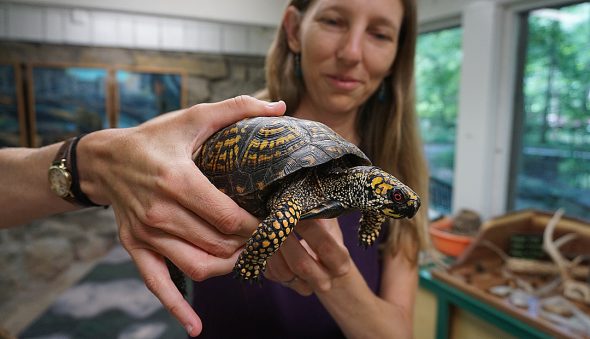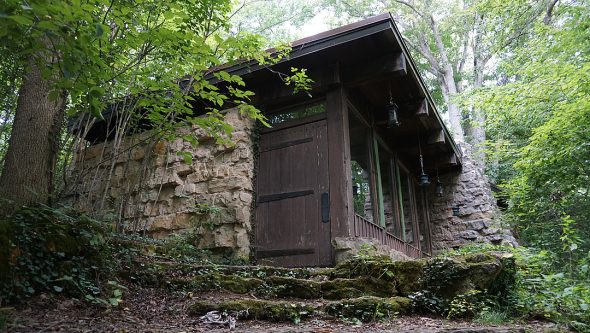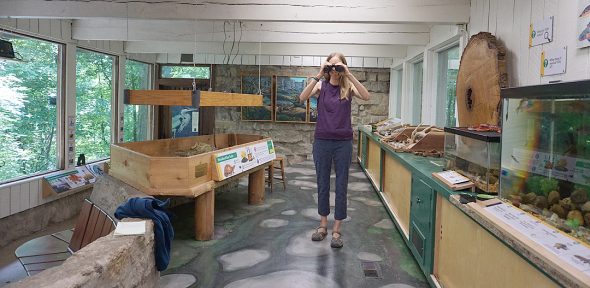
Even for the resident box turtle, Mr. Turkleton, Glen Helen’s Trailside Museum is a hands-on space for environmental education. The museum’s Deputy Director Kat Christen (shown here holding the animal ambassador — one of many at the museum) along with a number of Glen staffers and volunteers reopened the museum earlier this year, after its temporary closing in 2020. (Photo by Reilly Dixon)
A good summer for Glen Helen’s reopened Trailside Museum
- Published: August 13, 2024
Did you know that 75% of the human brain is water, and 75% of a living tree is also water? What about bats being the only mammal that can fly? That temperature determines the sex of a turtle before it hatches?
And how many species of native fish live in our wild Ohio waterways? The answer: over 170.
Within its stone walls — where the lines between indoor and outdoor are blurred — Glen Helen Nature Preserve’s Trailside Museum asks its guests to ponder these questions and more.
The museum, a stout building located atop the head of the Inman Trail, reopened its doors to adults and children alike earlier this summer after being closed since 2020. It temporarily shuttered owing both to the complications of COVID-19 and the sale of the Glen from Antioch College to the Glen Helen Association nonprofit.
Now, it’s new and improved, and open to the public.

Glen Helen’s Trailside Museum, built in 1952 by Antioch College students, sits at the top of the Inman Trail. (Photo by Reilly Dixon)
Using $50,000 in grants from CenterPoint Energy and the Yellow Springs Community Foundation, the Glen renovated the museum top to bottom, anticipating its 2024 reopening. With that money, staffers and volunteers rehabbed the building’s roof, HVAC system, added a bevy of educational materials and even brought in many new living critters — “animal ambassadors” hailing from the local land, who now call the museum home.
“We’re here to highlight and celebrate our local native plants and animals,” Glen Helen’s Deputy Director Kat Christen told the News this week. “The goal is to cultivate a sense of place — to ask, ‘Where are we in the world, specifically? What lives here?”
Christen joined the Glen staff — now over 50 strong, with twice as many regular volunteers — last year with a primary objective: to reopen the Trailside Museum and bring it up to snuff. It was built in 1952 by Antioch College students, and in the intervening half-century, has undergone few substantial improvements. According to Christen, before the recent overhaul, the museum had a crumbling roof, often had water pooled indoors and featured a “hodgepodge” of educational materials.
“And a hodgepodge is fine — because I think any kind of environmental education is great — but it’s better when you pull that information together in a way that more effectively attracts and engages kids,” Christen said, referring to the dozens of sleek, newly-designed informative placards and signs throughout the museum.
What is that little gray bird with a hood flitting around just outside the museum’s windows?
Well, a new sign will tell you all about that tufted titmouse — and that it’s likely to be joined by other native species like cardinals, chickadees, blue jays and more. The Glen, after all, is home to around 200 bird species — a number of which can be seen and heard from within the Trailside Museum.

Glen Helen’s Deputy Director Kat Christen encourages visitors to use the binoculars, magnifying glasses and more to experience the wildlife both in and outside of the museum. (Photo by Reilly Dixon)
“It’s our way of creating more educational space,” Christen said. “Our museum is small and modest, but there are plenty of interactive activities that bleed into the outside. Since we’ve put up a bunch of feeders, the bird population around the museum has grown — they come right up to the windows so they’re easier to see.”
As for the critters living within the space, there’s Mr. Turkleton, a woodland box turtle that the Glen rescued from an area roadway; a couple dozen aquatic creatures such as sunfish, creek chubs, darters and minnows; a couple curious-looking crayfish; and, on occasion, a slithery snake.
Elsewhere in the museum are new works of art and natural artifacts such as fossils, animal furs, snakeskins, tree bark, pinecones, bird nests and more — all free to be touched and interacted with, Christen said.
“A lot of what’s here is hands-on, tactile, accessible and interactive,” she said. “And you’ll notice that there are no [digital] screens anywhere — that’s intentional. In other educational museums, there are so many touch screens and bright lights everywhere. But there, I imagine kids are just pressing buttons to see a light instead of pressing it to learn about beavers.”
Since opening the Trailside Museum’s doors earlier this year, Christen said she’s seen kids and adults alike respond well to this interactivity. Throughout the space, there are “I spy” games, thought-provoking questions posted on the walls, magnifying glasses and binoculars. It’s an interactive ethos, Christen said, that’s underpinned by three questions she often poses to children: “What do you notice? What does it remind you of? What do you wonder about it?
“We want kids to explore on their own — to spread out,” Christen said. “On one side of the room, a kid may be reading from our library, another will be watching the fish and then another wanting to touch every single thing in here.”
She added, with a laugh: “I haven’t seen any kid in here who was bored.”

Many if not most of the educational exhibits in the Trailside Museum are interactive and tactile. (Photo by Reilly Dixon)
That’s saying a lot, considering how many youths have entered the museum since it reopened. As Christen said, this year’s Ecocamp — the Glen’s annual summer youth camping program that takes place from June through the end of July — brought in a couple hundred kids.
And, there’s the general public: “We tried to open during peak visitation in the Glen, which is summertime — and we get over 150,000 visitors throughout the year.”
Still, the newly-established hours at the Trailside Museum are somewhat limited. The goal, Christen said, is to open weekly, on Wednesdays and Saturdays, 1–4 p.m. It will be open this Saturday, but Christen was unable to say if the same would reliably be the case for the following weeks.
It’s a matter of bringing in more area volunteers to staff the museum, she said.
“We’re looking for more people who can volunteer to open it more often,” Christen said. “There’s just a little training, and in a short amount of time, you’ll know enough to open the space — to explore with kids.”
Of the ongoing importance of the Trailside Museum, Christen added: “I can’t think of a more important time to celebrate a sense of place and what animals and plants live here, in the Glen and in Greene County, and we can protect them — and to protect anything, you have to know what you’re protecting.”
She continued: “There’s a real world of nature happening all around us, and it’s important to recognize and learn about it.”
To volunteer at the Trailside Museum or to get involved with any of the other volunteer programs at Glen Helen, visit the nature preserve’s website at glenhelen.org/volunteer, or call 937-769-1902. Glen Helen’s address is 405 Corry St., and the Trailside Museum — as its name implies — is located at the head of the Inman Trail, right by the preserve’s main parking lot.
One Response to “A good summer for Glen Helen’s reopened Trailside Museum”
The Yellow Springs News encourages respectful discussion of this article.
You must login to post a comment.
Don't have a login? Register for a free YSNews.com account.














It is great to see Trailside re-opened. I have terrific memories of hours and hours spent there as a child.